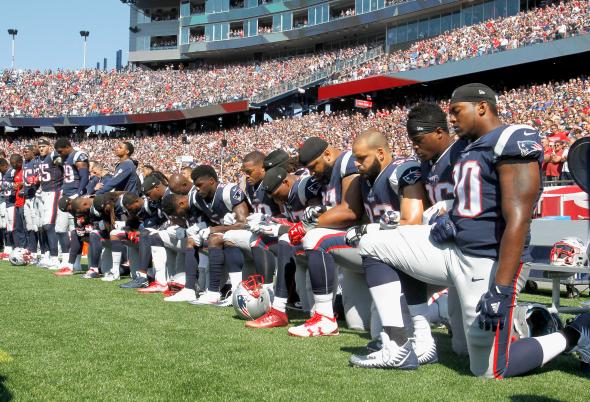How to Address the NFL Protests with Humility
September 24, 2017
Categories: Humility
Starting with Colin Kapernick last season, NFL players have protested unjust treatment toward African Americans and other persons of color by kneeling during the national anthem. Irrespective of your position on these protests, this is an issue that brings up strong feelings on all sides.
President Trump and NFL Protests
This weekend, President Trump sharply criticized NFL players who protested during the national anthem, saying he wished owners would fire the protesting players. “Wouldn’t you love to see some of these NFL owners, when someone disrespects our flag, to say, ‘Get that son of a bitch off the field right now. Out. He’s fired! He’s fired!’”
Trump’s statements won’t accomplish the goal of encouraging NFL players to stand during the national anthem, and it won’t help heal racial divisions in our country. Case in point: Following Trump’s comments, there was actually an increase in athlete protests during the national anthem this weekend. Trump’s actions backfired.
Here’s what Trump struggles to understand: Trying to enforce change on to others in an authoritarian manner doesn’t work. It only increases anger, frustration, and resistance.
If Trump wanted to effectively address the NFL protests, he would lead with humility.
Research on Humble Dialogue
I recently did a research project where I brought undergraduate students into the lab who disagreed on one of several contentious issues (e.g., gay marriage, abortion). Participants engaged in a discussion about the topic, and then students completed several questionnaires, including rating the humility of the discussion partner and how close they felt to that person. Participants also reported whether their opinion on the controversial issue had changed as a result of the discussion.
Humble discussion partners were associated with increased relationship closeness. Also, participants shifted their opinion on the controversial issue only when both discussion partners were high in humility.
10 Characteristics of Humble Dialogue
What does humble dialogue look like?
- Don’t make assumptions. Don’t assume you know a lot about the person you are in dialogue with. Instead, assume you don’t understand the other person’s experience and need to learn more.
- Don’t assume your viewpoint is superior. Don’t come to the table and assume your perspective is superior to the other person’s position. Make sure you are both standing on even ground.
- Be okay with being wrong. Most of us defend our viewpoint like it’s a battle. Instead, try to get comfortable with the idea that you could be wrong. We are all in process—no one has everything right.
- Be okay with changing your mind. Often people come to the table unwilling to change their mind. If you want another person to change their mind, you have to be willing to change yours as well.
- Be open to explore. Be other-focused and explore the position of the other person. Try to get a sense of where they are coming from.
- Listen first, talk second. To understand the viewpoint of the other person, you have to listen first. Also, actually listen. Don’t just wait for the other person to stop talking so you can jump in and say something.
- Engage with respect. Always respect the person you are in dialogue with. Treat them as a human being, not an object or obstacle.
- Separate the person from the position. People are complex. Don’t let one belief, attitude, or value dominate your opinion of the entire person.
- Aim for dialogue, not debate. Don’t try to “win” the conversation at the expense of the other person. Instead, make learning and understanding your primary goals.
- Aim for conversation, not conversion. Don’t focus on converting the other person to your point of view. Instead, try to have a respectful conversation and let that be your goal.
A Better Way to Address the NFL Protests
If Trump wants to be effective about engaging athletes (and the nation) about the NFL protests, he could try some of the following:
- Admit past mistakes around handling issues of race.
- Express a desire to understand the perspective of the protestors.
- Take concrete steps to educate himself about race and racism.
- Engage in humble dialogue with protestors and people of color.
- Use power and privilege to advocate for justice and equality.
By trying to strong-arm NFL protestors to see things his way, Trump’s actions backfired. However, if Trump could engage the protestors in humility, and begin to address the issues that led to the protests in the first place, Trump could take a huge step forward and bring this country together to heal the racial divisions that divide us.
Take-Home Point: If you want to effectively address an issue you care strongly about with someone who believes differently, engage with humility.

Related Thoughts
One Comment
Leave A Comment

Subscribe To My Newsletter
Join my mailing list to receive the latest blog posts.
Receive my e-book “The Mental Health Toolkit” for free when you subscribe.






Joshua welcome to living in the real world. Great ideas, but this is a job they are paid to do and a country they represent. They don”t need discussion they need to be fired, and told with humility why they are, end of story.